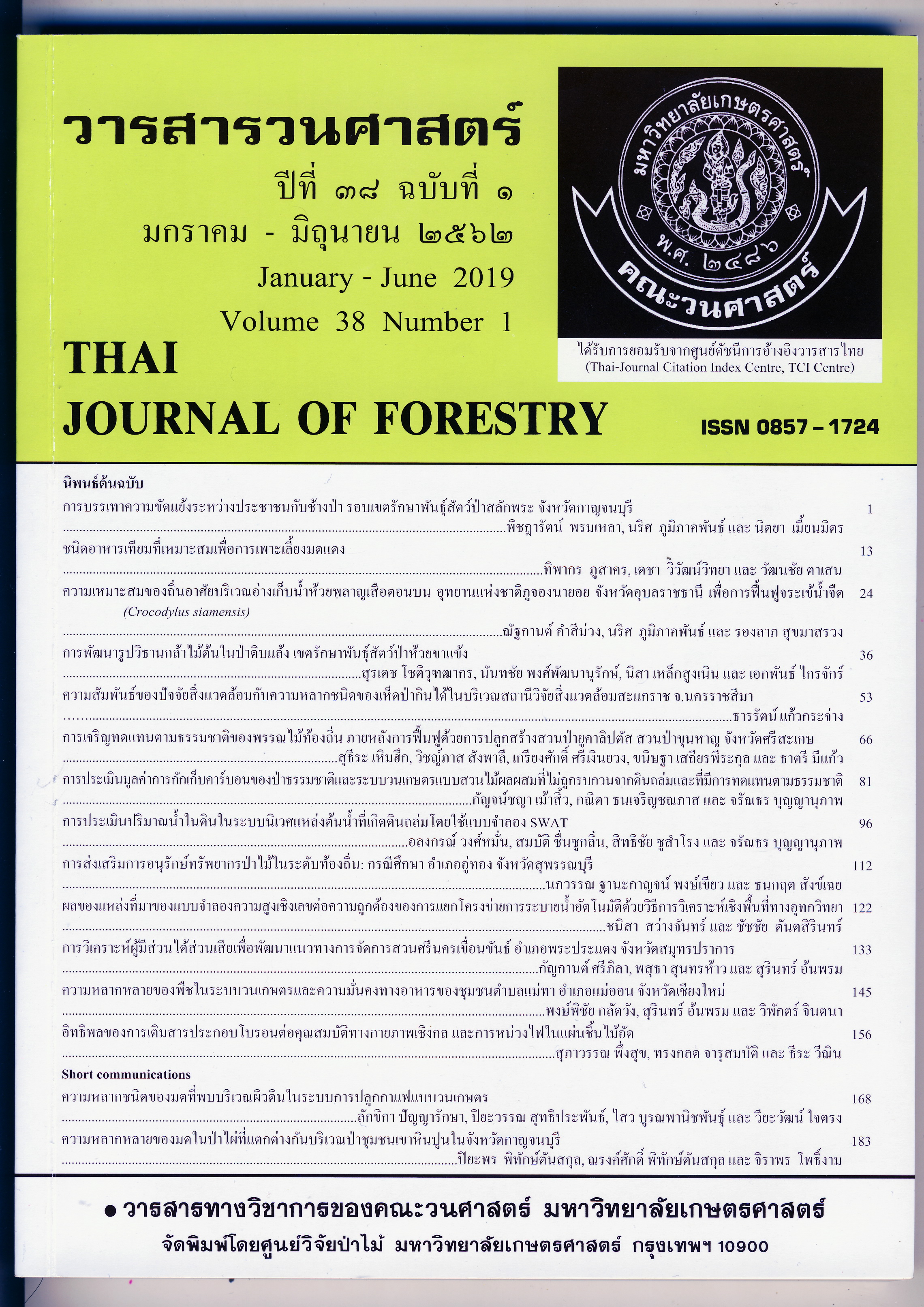ความหลากหลายของมดในป่าไผ่ที่แตกต่างกันบริเวณป่าชุมชนเขาหินปูนในจังหวัดกาญจนบุรี
Main Article Content
บทคัดย่อ
งานวิจัยนี้ได้ทำการศึกษาความหลากหลายทางชีวภาพของมดในป่าไผ่เขาหินปูนที่แตกต่างกัน 4 ประเภท ได้แก่ 1) ป่าผสมระหว่างไผ่รวกกับไผ่ไร่ (Thyrsostachys siamensis Gamble และ Gigantochloa albociliata (Munro) Kurz 2) ป่าไผ่รวก (T. siamensis Gamble) 3) ป่าไผ่ผาก (Gigantochloa densa) และ 4) ป่าไผ่ไร่ (Gigantochloa albociliata (Munro) Kurz.) บริเวณป่าชุมชนบ้านพุเตย ตำบลท่าเสา อำเภอไทรโยค จังหวัดกาญจนบุรี ระหว่างเดือนธันวาคม พ.ศ. 2560 ถึง เดือนมีนาคม พ.ศ. 2561 โดยมีวิธีดำเนินการสำรวจมด 2 วิธี คือการใช้กับดักน้ำหวาน และการเก็บด้วยมือ จากการศึกษาพบมดทั้งสิ้น 47 ชนิด 30 สกุล จาก 8 วงศ์ย่อย โดยพบความหลากชนิดของมดในป่าไผ่ผสมระหว่างไผ่รวกกับไผ่ไร่ จำนวน 27 ชนิด ป่าไผ่ไร่ จำนวน 27 ชนิด ป่าไผ่ผาก จำนวน 26 ชนิด และป่าไผ่รวกจำนวน 24 ชนิด ทั้งนี้พบว่าความหลากหลายทางชนิดพันธุ์ของมดไม่มีความแตกต่างกันอย่างมีนัยสำคัญทางสถิติในป่าไผ่ทั้ง 4 ประเภท ชนิดพันธุ์ท้องถิ่นของมดที่มีความสำคัญและพบมากสุดคือ มดหนามคู่ดำ (Diacama vargens) มดไอ้ชื่น (Odontoponera denticulata) มดคันกระโดด (Pheidole inornata) และมดคันหัวแบน (Pheidole pieli) โดยพบการปรากฏ ร้อยละ 100.00, 79.17, 62.50 และ 62.50 ตามลำดับ นอกจากนี้ยังมีชนิดพันธุ์รุกรานต่างถิ่นที่สำคัญ คือ มดเหม็น (Tapinoma melanocephalum) มดน้ำผึ้ง (Anoplolepis gracilipes) มดรำคาญขายาว (Paratrechina longicornis) และ มดละเอียดบ้าน (Monomorium pharaonis) ซึ่งพบมีการปรากฏร้อยละ 88.33, 62.50, 50 และ 50 ตามลำดับ โดยเฉพาะอย่างยิ่งในป่าไผ่ผากซึ่งมีความอุดมสมบูรณ์ของเศษซากใบไม้และความอุดมสมบูรณ์ของดินสูง พบมดในสกุลที่หายาก อาทิ มดคันทานโจ (Pheidole tandjongensis) มดกระโดดเหลือง (Odontomachus rixosus) มดปุยฝ้ายป่า (Ectomomyrmex astuta) และ สกุลมดปุยฝ้าย (Ectomomyrmex sp. 1) ซึ่งเป็นชนิดพันธุ์ที่มักพบในเศษซากของใบหรือในไม้ผุ ซึ่งผลการศึกษานี้พบว่าความหลากหลายทางชีวภาพมีความใกล้เคียงกับการศึกษาความหลากหลายทางชีวภาพของมดในพื้นที่อื่นๆ ของประเทศไทย
Downloads
Article Details
ข้าพเจ้าและผู้เขียนร่วม (ถ้ามี) ขอรับรองว่า ต้นฉบับที่เสนอมานี้ยังไม่เคยได้รับการตีพิมพ์และไม่ได้อยู่ในระหว่างกระบวนการพิจารณาตีพิมพ์ลงในวารสารหรือสิ่งตีพิมพ์อื่นใด ข้าพเจ้าและผู้เขียนร่วม (ถ้ามี) ยอมรับหลักเกณฑ์และเงื่อนไขการพิจารณาต้นฉบับ ทั้งยินยอมให้กองบรรณาธิการมีสิทธิ์พิจารณาและตรวจแก้ต้นฉบับได้ตามที่เห็นสมควร พร้อมนี้ขอมอบลิขสิทธิ์ผลงานที่ได้รับการตีพิมพ์ให้แก่วารสารวนศาสตร์ คณะวนศาสตร์ มหาวิทยาลัยเกษตรศาสตร์ กรณีมีการฟ้องร้องเรื่องการละเมิดลิขสิทธิ์เกี่ยวกับภาพ กราฟ ข้อความส่วนใดส่วนหนึ่ง หรือ ข้อคิดเห็นที่ปรากฏในผลงาน ให้เป็นความรับผิดชอบของข้าพเจ้าและผู้เขียนร่วม (ถ้ามี) แต่เพียงฝ่ายเดียว และหากข้าพเจ้าและผู้เขียนร่วม (ถ้ามี) ประสงค์ถอนบทความในระหว่างกระบวนการพิจารณาของทางวารสาร ข้าพเจ้าและผู้เขียนร่วม (ถ้ามี) ยินดีรับผิดชอบค่าใช้จ่ายทั้งหมดที่เกิดขึ้นในกระบวนการพิจารณาบทความนั้น”
เอกสารอ้างอิง
Antwiki. 2018. Category: Extant species. Available source: http://www.antwiki.org/wiki/Category:Extant_species, October 9, 2018.
Bolton, B. 1994. Identification Guide to the Ant Genera of the World. Harvard University Press.
Bourmas, C. and D. Wiwatwitaya. 2005. Species diversity of ants at Huay Khayeng, Thong Pha Phum district, Kanchanaburi province.Thai Journal of Forestry 24: 59-72.
Dac, N.D. and N.L.T. Phuong. 2016. Diversity and abundance of ants (Hymenoptera: Formicidae) in Phu Luong, Thai Nguyen province, Vietnam. Journal of Vietnamese Environment 8(1): 45-49.
Hashimoto, Y., S.K. Yamane and M. Mohamed. 2001. How to design an inventory method for ground-level ants in tropical forests. Nature abs Human Activities 6: 25-30.
Hölldobler, B. and E.O. Wilson. 1990. The Ants.Cambridge: Belknap Press.
Hosoishi, S., A. Le Ngoc, S.K. Yamane and K. Ogata. 2013. Ant diversity in rubber plantations (Hevea brasiliensis) of Cambodia. Asian Myrmecology 5: 69-77.
Jaitrong, W., P. Kumthong and S. Hasin. 2007. Nest structure and nesting habitats of Polyrhachis muelleri Forel, 1893 in Eastern Thailand (Hymenoptera: Formicinae). The Thailand Natural History Museum Journal 2(1): 19-25.
Jaitrong, W. and T. Jeenthong. 2014. Ant faunae of Mu Koh Lanta National Park, Krabi province, pp.47-61. In D. Prathumthong, W. Sanguansombat and W. Jaitrong, eds. The Rapid Biodiversity Assessment of Mu Koh Lanta.
Jaitrong, W. and J. Nabhitabha. 2005. A list of known ant species of Thailand (Formicidae:Hymenoptera). The Thailand Natural History Museum Journal 1(1): 9-54.
Jaitrong W. and T. Ting-nga. 2005. Ant fauna of Peninsular Botanical Garden (Khao Chong), Trang Province, Southern Thailand (Hymenoptera: Formicidae). The Thailand Natural History Museum Journal 1(2): 137-147.
Jaitrong, W. 2011. Identification Guide to the Ant genera of Thailand. National Science Museum, Pathum Thani.
Jongjitvimol, T. and W. Wattanachaiyingcharoen. 2010. Species diversity of ants (Hymenoptera:Formicidae) at the mixed deciduous forest in Phanom Rung Historical Park, Buriram province. NU Science Journal 7(1): 114-123.
Kaewrungruang, M., R. Dokmaithes and S. Sanguansub. 2016. Diversity of ant in different land use types at Kasetsart University, Kamphaeng Saen campus. Khon Kaen Agriculture Journal 44(2): 287-294.
Krebs, J.C. 1999. Ecological methodology. Vol. 620 benjamin/Cummings, Menlo Park, California.
Liefke, C., W.H.O. Dorow, B. Hölldobler and U.Maschwitz. 1998. Nesting and food resourses of syntopic species of the ant genus Polyrhachis (Hymenoptewra, Formicidae) in West-Malaysia. Insectes Sociaux 45: 411-425.
Onishi, Y., W. Jaitrong, P. Suttiprapan, S. Buranapanichpan, Y. Chanbang and F. Ito. 2016. Ant species diversity in coffee plantation in Chiang Mai province, northern Thailand. The Thailand Natural History Museum Journal 10 (1): 33-48.
Phongam, J., P. Pitaktunsakul, T. Soompee. 2015.Species diversity of ants in the bamboo forest, Khuean Srinagarindra National Park Kanchanaburi Province. Journal of Kanchanaburi Rajabhat University 4(1) : 82-90
Pielou, E.C. 1966. Shannon’s formula as a measure of species diversity: its use and misure. Am.Nat. 100: 463-465.
Poonjampa, R. and D. Wiwatwitaya. 2004. Comparison of species diversity of ants in plant communities at Khao Yai National Park. Thai Journal of Forestry 23: 24-36.
Shattuck, S.O. 1999. Australian Ants. Their biology and identification. Monographs on Invertebrate Taxonomy 3: 226
Sorrensen, B. 1984. Physical Measurement as Risk Indicators for Low-Back Trouble over One Year Period. Journal of Spinal Disorders and Techniques 9: 106-119.
Thongphak, D. and C. Kulsa. 2014. Diversity and community composition of ants in the mixed deciduous forest, the pine forest and the para rubber plantation at Chulaborn Dam, Chaiyaphum Province, the northeastern
Thailand. IJERD – International Journal of Environmental and Rural Development(2014) 5-1: 72-76.
Torchote, P., D. Sitthicharoenchai and C. Chaisuekul. 2010. Ant species diversity and community composition in three different habitats: mixed deciduous forest, teak plantation and fruit orchard. Tropical Natural History
(1): 37-51.
Watanasit, S., S. Tongjerm and D. Wiwatwitaya. 2005. Composition of canopy ants (Hymenoptera:Formicidae) at Ton Nga Chang Wildlife Sanctuary, Songkhla province, Thailand. Songklanakarin J. Sci. Technol. 27(Suppl.3): 665-673.
Watanasit, S., N. Noon-anant and A. Phlappueng. 2008.Diversity and ecology of ground dwelling ants at Khao Nan National Park, southern Thailand. Songklanakarin J. Sci. Technol.30(6): 707-712.
Watanasit, S. and T. Nhu-eard. 2011. Diversity of ants (Hymenoptera: Formicidae) in two rubber plantations in Songkhla Province, southern Thailand. Songklanakarin J. Sci. Technol.33 (2): 151-161.
Wetterer, J. K. 2005. Worldwide distribution and potential spread of the long-legged ant, Anoplolepis gracilipes (Hymenoptera: Formicidae). Sociobiology 45:77-97.
Wiwatwitaya, D. and W. Jaitrong. 2001. Identification Guide to the ants of Khao Yai National Park. Department of Forest Biology, Faculty of Forestry, Kasetsart University, Bangkok.
Yanoviak, S.P., B.L. Fisher and A. Alonso. 2007. Arboreal ant diversity (Hymenoptera: Formicidae) in a central African forest. African Journal of Ecology 46(1): 60 - 66.


